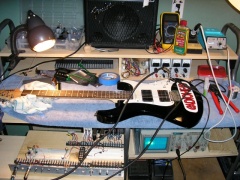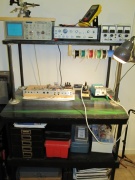
Here is where I do most of my electronics work. I have a garage full of woodworking tools to support my other, more expensive hobbies, but I don't do much electronics stuff there unless it's too big to work on at my usual bench.

It's little cramped, but I have everything I need. Scope, waveform generator, and power supply are on the top shelf - out of the way but within easy reach. I also have a work lamp and some wire and solder on spools (very convenient!) up there. My soldering iron and rapid prototype board (I'll get to that in a second) live on the bench most of the time. Down below is my parts bin, a couple of toolboxes, screwdriver set, a box for wire and tape and stuff, and a box full of BNC patch cables. One the floor in another small parts bin, a box full of various salvaged enclosures, and a big pile of old schoolwork that doesn't belong here but doesn't fit in my file cabinet.
The bench itself is made from 3/4" plywood and 1"x3" pine boards. The base and lower shelf are finished in Duplicolor spray-on truckbed liner, while the top and upper shelf were painted with acrylic artist's paints and coated with Minwax semigloss polyurethane varnish. The upper shelf is held up with 1" diameter pipe and fittings -- an expensive, but sturdy way to do it.
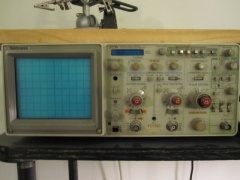
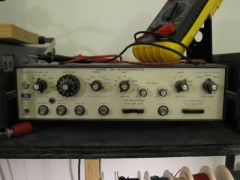
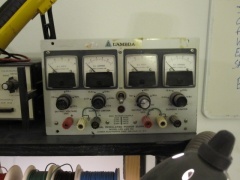
My oscilloscope is a Tektronics 2236 CRT model. It has two channels, a built-in multimeter, and a frequency counter. Old as it it, I like it a lot. No fancy cursors, endless menus, myriad trigger options, or any of the other trappings of modern DSOs. It's easy to set up and use, and has the features I need for basic circuit development and debugging. My waveform generator is an Exact Model 124. I don't know much about the company, but the waveform generator is fine for my needs. The power supply is a Lambda dual model. It will put out up to 40V at 1A per channel, which is plenty for the vast majority of my projects.
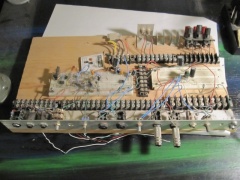
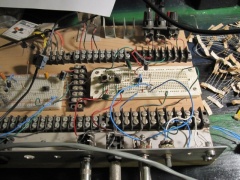
My rapid prototype board is pure circuit prototyping coolness. It's basically a bunch of connectors, breadboards, and terminal strips screwed to a piece of wood. The cool factor comes from how easily a breadboarded circuit can be securely attached to jacks, pots, switches, and any other off-board components I need. The front is just a piece of angle aluminum with a bunch of holes drilled in in. I can put switches, pots, or anything else I need in there. Behind the aluminum angle is a series of terminal strips that allow me to go from the components to the breadboards in a modular fashion. On the back of the board are power connectors (molex, banana jacks, DC connectors, and 9V battery clips) also hooked up to terminal strips.
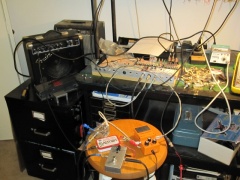
Too bad I didn't get the test equipment in the shot, but you can imagine that's where the hanging leads are coming from. I'm testing my boost pedal in this picture.
And, just for historical purposes, here's my old bench - a cheap particle board desk from Wal-Mart.
